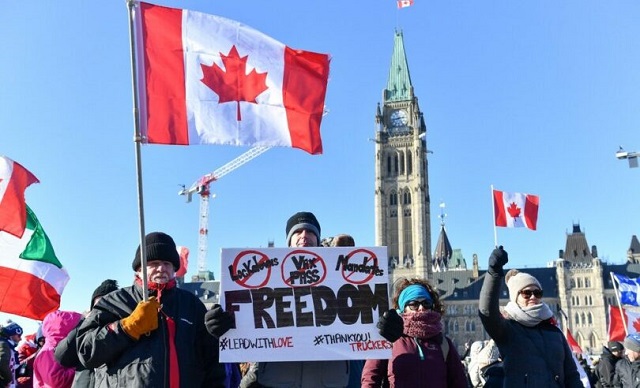Brownstone Institute
The White House’s ‘Misinformation’ Pressure Campaign Was Unconstitutional

From the Brownstone Institute
BY
I am one of five private plaintiffs in the landmark free speech case Missouri v. Biden. Earlier this month, the Fifth Circuit Court found that the government “engaged in a years-long pressure campaign designed to ensure that the censorship [on social media] aligned with the government’s preferred viewpoints” and that “the platforms, in capitulation to state-sponsored pressure, changed their moderation policies.” This resulted in the censoring of constitutionally protected speech of hundreds of thousands of Americans, tens of millions of times. Based on this finding, the Fifth Circuit in part upheld an injunction on certain public officials put in place by a district court.
Even when the government appealed the injunction to the Fifth Circuit, its lawyers hardly disputed a single factual finding from the court’s ruling. A unanimous three-judge panel upheld the core findings that “several officials—namely the White House, the Surgeon General, the CDC, and the FBI—likely coerced or significantly encouraged social-media platforms to moderate content, rendering those decisions state actions. In doing so, the officials likely violated the First Amendment.” The government again appealed the injunction to the Supreme Court, where we expect a ruling this week.
The government’s claim that the injunction limits public officials’ own speech is absurd misdirection. The government can say whatever it wants publicly; it just cannot stop other Americans from saying something else. Free speech matters not to ensure that every pariah can say whatever odious thing he or she chooses. Rather, free speech prevents the government from identifying every critic as a pariah whose speech must be shut down.
We are all harmed when our rulers silence criticism. Our government’s self-inflicted deafness prevented officials and their constituents from hearing viewpoints that should have had a meaningful impact on our policy decisions. Instead, government censorship resulted time and again in the silencing of scientifically informed criticisms of, for example, harmful COVID policies. This allowed misguided and divisive policies to persist far too long.
The scope of the current government censorship regime is historically unprecedented. “The present case arguably involves the most massive attack against free speech in United States’ history,” the district court judge explained in his ruling. He went on, “The evidence produced thus far depicts an almost dystopian scenario… The United States Government seems to have assumed a role similar to an Orwellian ‘Ministry of Truth’.” The Fifth Circuit panel concurred: “The Supreme Court has rarely been faced with a coordinated campaign of this magnitude orchestrated by federal officials that jeopardized a fundamental aspect of American life.”
The government’s only attempted defense is that it was merely offering help to the platforms without jawboning them—”just your friendly neighborhood government agency.” But the law is clear that even “significant encouragement” to censor protected speech—not just overt threats or coercion—is unconstitutional. We discovered that social media companies frequently tried to push back against government demands, before finally caving to relentless pressure and threats. The evidence we presented from 20,000 pages of communications between government and social media demonstrated both significant encouragement and coercion—as when Rob Flaherty, White House director of digital strategy, berated executives at Facebook and Google, dropping F-bombs, launching tirades, and browbeating the companies into submission—until they removed even a parody account satirizing President Joe Biden.
But the more insidious and powerful censorship happens when government pressures companies to change their terms of service and modify their algorithms to control what information goes viral and what information disappears down the memory hole. With sophisticated deboosting, shadowbanning, search results prioritization, and so forth, citizens do not even realize they are being silenced, and viewers remain unaware that their feeds are carefully curated by the government. Novelist Walter Kirn compared this to mixing a record: turn the volume up on this idea (more cowbell) and turn the volume down on that idea (less snare drum). The goal is complete top-down information control online.
We were dismayed to discover the number of government agencies now engaged in censorship (at least a dozen) and the range of issues they targeted: the State Department censored criticism of our withdrawal from Afghanistan and the Ukraine War, the Treasury Department censored criticism of our monetary policy, the FBI (surprise!) ran point on several censorship ops, and even the Census Bureau got in on the game. Other targeted topics ranged from abortion and gender to election integrity and COVID policy.
Much of the state censorship grunt work is outsourced to a tightly integrated network of quasi-private (i.e., government funded) NGOs, universities, and government cutouts employing thousands of people working round the clock to flag posts for takedown. But constitutional jurisprudence is clear: the government cannot outsource to private entities actions that would be illegal for the government itself to do. If a government agent hires a hit man, he is not off the hook simply because he did not personally pull the trigger.
So-called “misinformation research” at places like the Stanford Internet Observatory is a slippery euphemism for censorship—not only because Facebook executives admitted to censoring “often true” but inconvenient information under government pressure, but because these entities function as laundering operations for government censorship.
Recent attempts to rebrand the work of the censorship-industrial complex with more anodyne euphemisms—”information integrity” or “civic participation online”—don’t change the fact that this is not disinterested academic research, but cooperation in state-sponsored suppression of constitutionally protected speech, always in favor of the government’s preferred narratives.
CISA, the government’s censorship switchboard and clearinghouse agency housed within the Department of Homeland Security, described its work as protecting our “cognitive infrastructure”—i.e., the thoughts inside your head—from bad ideas, such as the ones advanced in this article. (Not kidding: YouTube recently censored a video of our lawyers giving a talk on our censorship case.) These ideas aren’t throttled by government censors because they are untrue, but because they are unwelcome. There’s a more accurate term for the government’s takeover of our “cognitive infrastructure:” mind control. I don’t know a single American of any political persuasion who wants to be subjected to that.
Republished from Newsweek
Brownstone Institute
The WHO’s Proposed Pandemic Agreements Worsen Public Health

From the Brownstone Institute
BY
The WHO decided that the response for a Toronto aged care resident and a young mother in a Malawian village should be essentially the same – stop them from meeting family and working, then inject them with the same patented chemicals.
Much has been written on the current proposals putting the World Health Organization (WHO) front and center of future pandemic responses. With billions of dollars in careers, salaries, and research funding on the table, it is difficult for many to be objective. However, there are fundamentals here that everyone with public health training should agree upon. Most others, if they take time to consider, would also agree. Including, when divorced from party politicking and soundbites, most politicians.
So here, from an orthodox public health standpoint, are some problems with the proposals on pandemics to be voted on at the World Health Assembly at the end of this month.
Unfounded Messaging on Urgency
The Pandemic Agreement (treaty) and IHR amendments have been promoted based on claims of a rapidly increasing risk of pandemics. In fact, they pose an ‘existential threat’ (i.e. one that may end our existence) according to the G20’s High Level Independent Panel in 2022. However, the increase in reported natural outbreaks on which the WHO, the World Bank, G20, and others based these claims is shown to be unfounded in a recent analysis from the UK’s University of Leeds. The main database on which most outbreak analyses rely, the GIDEON database, shows a reduction in natural outbreaks and resultant mortality over the past 10 to 15 years, with the prior increase between 1960 and 2000 fully consistent with the development of the technologies necessary to detect and record such outbreaks; PCR, antigen and serology tests, and genetic sequencing.
The WHO does not refute this but simply ignores it. Nipah viruses, for example, only ‘emerged’ in the late 1990s when we found ways to actually detect them. Now we can readily distinguish new variants of coronavirus to promote uptake of pharmaceuticals. The risk does not change by detecting them; we just change the ability to notice them. We also have the ability to modify viruses to make them worse – this is a relatively new problem. But do we really want an organization influenced by China, with North Korea on its executive board (insert your favorite geopolitical rivals), to manage a future bioweapons emergency?
Irrespective of growing evidence that Covid-19 was not a natural phenomenon, modelling that the World Bank quotes as suggesting a 3x increase in outbreaks over the next decade actually predicts that a Covid-like event will recur less than once per century. Diseases that the WHO uses to suggest an increase in outbreaks over the past 20 years, including cholera, plague, yellow fever, and influenza variants were orders of magnitude worse in past centuries.
This all makes it doubly confusing that the WHO is breaking its own legal requirements in order to push through a vote without Member States having time to properly review implications of the proposals. The urgency must be for reasons other than public health need. Others can speculate why, but we are all human and all have egos to protect, even when preparing legally binding international agreements.
Low Relative Burden
The burden (e.g. death rate or life years lost) of acute outbreaks is a fraction of the overall disease burden, far lower than many endemic infectious diseases such as malaria, HIV, and tuberculosis, and a rising burden of non-communicable disease. Few natural outbreaks over the past 20 years have resulted in more than 1,000 deaths – or 8 hours of tuberculosis mortality. Higher-burden diseases should dominate public health priorities, however dull or unprofitable they may seem.
With the development of modern antibiotics, major outbreaks from the big scourges of the past like Plague and typhus ceased to occur. Though influenza is caused by a virus, most deaths are also due to secondary bacterial infections. Hence, we have not seen a repeat of the Spanish flu in over a century. We are better at healthcare than we used to be and have improved nutrition (generally) and sanitation. Widespread travel has eliminated the risks of large immunologically naive populations, making our species more immunologically resilient. Cancer and heart disease may be increasing, but infectious diseases overall are declining. So where should we focus?
Lack of Evidence Base
Investment in public health requires both evidence (or high likelihood) that the investment will improve outcomes and an absence of significant harm. The WHO has demonstrated neither with their proposed interventions. Neither has anyone else. The lockdown and mass vaccination strategy promoted for Covid-19 resulted in a disease that predominantly affects elderly sick people leading to 15 million excess deaths, even increasing mortality in young adults. In past acute respiratory outbreaks, things got better after one or perhaps two seasons, but with Covid-19 excess mortality persisted.
Within public health, this would normally mean we check whether the response caused the problem. Especially if it’s a new type of response, and if past understanding of disease management predicted that it would. This is more reliable than pretending that past knowledge did not exist. So again, the WHO (and other public-private partnerships) are not following orthodox public health, but something quite different.
Centralization for a Highly Heterogeneous Problem
Twenty-five years ago, before private investors became so interested in public health, it was accepted that decentralization was sensible. Providing local control to communities that could then prioritize and tailor health interventions themselves can provide better outcomes. Covid-19 underlined the importance of this, showing how uneven the impact of an outbreak is, determined by population age, density, health status, and many other factors. To paraphrase the WHO, ‘Most people are safe, even when some are not.’
However, for reasons that remain unclear to many, the WHO decided that the response for a Toronto aged care resident and a young mother in a Malawian village should be essentially the same – stop them from meeting family and working, then inject them with the same patented chemicals. The WHO’s private sponsors, and even the two largest donor countries with their strong pharmaceutical sectors, agreed with this approach. So too did the people paid to implement it. It was really only history, common sense, and public health ethics that stood in the way, and they proved much more malleable.
Absence of Prevention Strategies Through Host Resilience
The WHO IHR amendments and Pandemic Agreement are all about detection, lockdowns, and mass vaccination. This would be good if we had nothing else. Fortunately, we do. Sanitation, better nutrition, antibiotics, and better housing halted the great scourges of the past. An article in the journal Nature in 2023 suggested that just getting vitamin D at the right level may have cut Covid-19 mortality by a third. We already knew this and can speculate on why it became controversial. It’s really basic immunology.
Nonetheless, nowhere within the proposed US$30+ billion annual budget is any genuine community and individual resilience supported. Imagine putting a few billion more into nutrition and sanitation. Not only would you dramatically reduce mortality from occasional outbreaks, but more common infectious diseases, and metabolic diseases such as diabetes and obesity, would also go down. This would actually reduce the need for pharmaceuticals. Imagine a pharmaceutical company, or investor, promoting that. It would be great for public health, but a suicidal business approach.
Conflicts of Interest
All of which brings us, obviously, to conflicts of interest. The WHO, when formed, was essentially funded by countries through a core budget, to address high-burden diseases on country request. Now, with 80% of its use of funds specified directly by the funder, its approach is different. If that Malawian village could stump up tens of millions for a program, they would get what they ask for. But they don’t have that money; Western countries, Pharma, and software moguls do.
Most people on earth would grasp that concept far better than a public health workforce heavily incentivized to think otherwise. This is why the World Health Assembly exists and has the ability to steer the WHO in directions that don’t harm their populations. In its former incarnation, the WHO considered conflict of interest to be a bad thing. Now, it works with its private and corporate sponsors, within the limits set by its Member States, to mold the world to their liking.
The Question Before Member States
To summarize, while it’s sensible to prepare for outbreaks and pandemics, it’s even more sensible to improve health. This involves directing resources to where the problems are and using them in a way that does more good than harm. When people’s salaries and careers become dependent on changing reality, reality gets warped. The new pandemic proposals are very warped. They are a business strategy, not a public health strategy. It is the business of wealth concentration and colonialism – as old as humanity itself.
The only real question is whether the majority of the Member States of the World Health Assembly, in their voting later this month, wish to promote a lucrative but rather amoral business strategy, or the interests of their people.
Brownstone Institute
Medical Elites’ Disgrace Over Ivermectin

From the Brownstone Institute
BY
In the wake of the FDA settling a lawsuit brought against it for wantonly and aggressively smearing ivermectin, the agency has deleted its postings. That’s good, but we shouldn’t forget how egregiously it mischaracterized the drug, ignored copious evidence in its favor, and portrayed its proponents as dangerous crackpots.
About 30 months ago, America’s FDA was publishing articles with headlines like this: “Should I take ivermectin to treat COVID?” Answer: No. The agency also told Americans not to use ivermectin to prevent Covid. Then, in what became known as its infamous “horse tweet,” the FDA even patronizingly told Americans: “Seriously, y’all. stop it.”
Prescribers who advocated for alternate treatments like ivermectin or hydroxychloroquine were mocked online by America’s “trusted journalists” as being part of a “right-wing conspiracy” and labeled “hucksters.” Those who didn’t demure to the Covid mRNA or other Big Pharma treatment narratives were banned, fired, and spoken harshly about around the world and into the reaches of the stratosphere in what seemed like coordinated messaging.
Many clinicians lost their jobs – at best. At worst, their reputations, practices, finances, and careers were shattered. If that was not bad enough, after losing their jobs, state medical and pharmacy boards initiated legal proceedings against their licensure, singling out their “off-label” Covid treatments, despite other off-label treatments being a near-ubiquitous component of pharmacy and medical practice.


Within days of FDA’s initial postings above, the American Pharmacist’s Association (APhA) the American Society of Health System Pharmacists (ASHP), and the American Medical Association (AMA) all collaborated to release a joint press release condemning doctors who prescribed ivermectin to treat Covid, but it appears that these organizations, instead of actually performing independent analysis of primary literature data, blindly regurgitated FDA, CDC, and NIH plus other government and Big Pharma talking points “strongly opposing” ivermectin use.
For generations and especially during the Covid pandemic, professionals depended on these “elite” medical groups. Some of them have existed for around 170 years and have around $150 million to $1.2 billion in assets, so they clearly had the history, personnel, and wherewithal to objectively examine published data. Even beyond that, the AMA has several floors in a skyscraper in Chicago and the APhA’s Constitution Avenue’s “landmark headquarters” is so luxuriant that it is advertised and utilized as a wedding venue.
Of course, that extravagance was paid for by millions of pharmacists, physicians, and benefactors who expected these organizations to act as a checksum and ensure excellent clinical practice standards. These medical organizations have a duty to honor their histories, responsibilities, and ethical duties to better the human condition through verified scientific evidence. Instead, they appeared to outrageously abandon their obligations from their lofty positions of respect, comfort, money, and power.
APhA, ASHP, and AMA Clinical Declarations Now Indefensible:
On March 22, the FDA rightly acquiesced and agreed to remove their anti-ivermectin postings due to 1) a lawsuit filed against them and 2) the impossible task of having to defend themselves with an overwhelming amount of data disagreeing with not only dispensing medical recommendations, but the published data backing their Covid-19 use (e.g., see below).
With that gone, the APhA, ASHP, and AMA assertions suddenly have no leg upon which to stand.
Several non-FDA links within their press releases have (unsurprisingly) also quietly vanished with no explanation. NIH references are slated to be shut down, on top of multiple FDA and CDC links already no longer working.
Ivermectin Mechanism of Action, History and Evidence:
The broad antiviral mechanism of action of ivermectin is complicated and may partially involve blocking the uptake of viral proteins, but the bottom line is that it has been shown to yield positive results in a variety of published results for Covid-19. Had APhA, ASHP, and AMA pharmacists and physicians independently examined the data, (as I, just one drug-safety analyst without fancy headquarters, have done) rather than simply parroting now-deleted narratives of others, they would have learned that ivermectin works as an antiviral.
It has an extensively proven track record of being not just safe – but astonishingly safe for a variety of viral diseases. This is not breaking or fringe science; it has been known for years. Ivermectin is such a safe and effective drug that back in 2015 it was the first drug for infectious disease associated with a Nobel Prize in 60 years.
While I have stacks of electronic files and printed materials, dog-eared and food/drink-stained, there is a most elegantly presented meta-analysis website designed by some brainy and web-savvy scientists detailing over 100 studies from over 1,000 different scientists, involving over 140,000 patients in 29 countries describing the benefit and safety of ivermectin for Covid-19 treatment. It actually appears to be more extensive than Cochrane’s outdated review of ivermectin which only examined 14 trials – and excluded seven of them from consideration.

According to these data, consisting of smaller international publications that include real-world findings and small observational studies, ivermectin shows a statistically significant lower Covid-19 risk as detailed in the image above.
The less-positive findings associated with late treatment/viral clearance/hospitalization data cohort were associated with delayed administration. That is because any late-state use of antiviral pharmacology tends to be ineffective after hundreds of millions of viral replications have taken place – whether it’s cold sores, influenza, AIDS, or Covid-19.
ASHP, APhA, and AMA Press Releases Contradict Available Data and Clinical Practice Standards:
When the FDA scolded Americans not to use ivermectin for Covid-19, on April 25, 2021, there were 43 different published manuscripts showing its potential benefit. Around three months later, on August 21, the FDA released its infamous horse/cow tweet which implied that ivermectin was only for animals, not humans. This “doubling down” occurred as an additional 20 studies had subsequently been written detailing additional benefits for Covid-19. See the timeline below:

Multiple APhA/ASHP/AMA statements ignored published scientific and clinical evidence. Specifically, statements declaring the: “Use of ivermectin for the prevention and treatment of COVID-19 has been demonstrated to be harmful to patients” (bold emphasis theirs) are objectively inaccurate. I do not know on what basis those statements were made. The recommendation to healthcare professionals to “…counsel patients against use of ivermectin as a treatment for COVID-19, including emphasizing the potentially toxic effects of this drug” represents a departure from pharmacist and physician practice standards.
The absurdity of the latter statement is quite outrageous. Pharmacists and physicians know that all drugs have “…potentially toxic effects” so if they applied the standard of “emphasizing potentially toxic effects” while discussing every prescribed medication, few if any patients would ever take any of their medications. The APhA/ASHP/AMA discriminatory hostility towards ivermectin was not only clinically unjustified and irresponsible; it was – as far as I know – without precedent.
These anti-ivermectin talking points also benefited new Big Pharma product advancement including the rebounding, overpriced taxpayer-funded boondoggle of Paxlovid and Remdesivir, such a “safe and effective” drug that hospitals had to be heavily incentivized (i.e., bribed) to entice nurses, physicians, and hospital administrators to promote its use with a staggering 20% “bonus” on the entire hospital bill paid by our federal government. Remdesivir quickly earned the sardonic nickname of “run-death-is-near” by American Frontline Nurses and others, due to serious questions about its clinical benefit.
Why were federal agencies’ and professional organizations’ talking points against ivermectin not backed by independent, original APhA/ASHP/AMA data examinations? That question needs to be thoroughly probed with regard to potential regulatory capture within these groups.
Both then and now, those FDA webpages, postings, and tweets were not just biased. They were irresponsible in their denigrating ivermectin as an off-label treatment, which is why they are now gone.
The question is, who was worse? The FDA for overstepping its congressional authority in not just making medical recommendations, but making recommendations ignoring data, or the servile “independent” elite professional organizations exuberantly echoing a narrative?
Prescient or not, here is an excerpt of the expert panel congressional testimony to the Covid Select House Oversight Committee, explaining the FDA’s disparaging ivermectin versus promoting mRNA injections using an automobile analogy, delivered just one day prior to the FDA’s yielding to physicians’ lawsuit to remove its postings denigrating ivermectin:
Despite FDA Settlement and Data Abundance, the Press is Still Anti-Ivermectin
Even after the FDA’s about-face, on March 26, 2024, a Los Angeles Times journalist published a column calling the removal of FDA tweets “groundless” unilaterally declaring ivermectin is still “conclusively shown to be useless against COVID-19,” comparing ivermectin to “snake oil,” and describing those who advocate for it as “purveyors of useless but lucrative nostrums” …whatever that means. (Regarding the ‘lucrative’ claim, it is worth noting that since ivermectin is generic and inexpensively available, it is not ‘lucrative’ to anyone.) It also referenced ivermectin lacking “scientific validation,” even though the above-cited data abundantly indicates otherwise.
Regarding the FDA’s choice to settle its lawsuit disparaging ivermectin, the FDA’s Center for Drug Evaluation and Research leadership isn’t “shooting itself in the foot” as the Times says. It seems that the FDA is indirectly attempting to prevent further embarrassment likely because it now realizes that its ivermectin assertions were wrong and outdated with every passing day. But where does that leave the APhA, ASHP, or AMA who heavily relied on these now deleted FDA links in their press releases?
The APhA, ASHP, AMA Response to the FDA’s Removal of Postings Used in Press Releases? An Embarrassing Silence:
Over a month later, and as of this publication date, none of these organizations have a single thing to say about their previous press releases quoting the now-removed FDA articles and tweets. In fact, here is an indication of their concerns: one week after the FDA acquiesced to remove its postings in ivermectin, APhA’s newly elected speaker chair and pharmacist Mary Klein is “happy danc[ing]” and giving her official acceptance speech wearing Mickey Mouse ears. ASHP’s (A/K/A “#MedicationExperts”) still shows its official page with clinicians wearing ineffective, unnecessary surgical masks despite the pandemic having ended well over a year ago and Cochrane reviews indicating that this sort of masking is almost certainly ineffective. AMA officials are making multiple posts on transgender issues and declaring climate change a public health crisis, – all while fully ignoring its impactful, incorrect, inappropriate statements on ivermectin.
Take a look:


The APhA, ASHP, and AMA have remained conspicuously silent on this topic while focusing their newsfeeds on everything but. To this day, their press releases remain online, with multiple dead links to government agencies. In blindly backing incorrect narratives pointing to removed web pages, they are now all alone in their ivermectin declarations.
Bottom line: ivermectin was and is safe, and more than likely effective for Covid when timed and dosed correctly, and under medical supervision, despite what was declared by organizations and federal officials. In fact, ivermectin’s general antiviral activity might even be helpful for bird flu (avian influenza) in animals and humans, in lieu of another novel adverse-event-ridden “warp speed” mRNA “vaccine” with an endless boondoggle of boosters.
The past and current record on ivermectin needs to be set straight. We know there is an important (but untransparent) list of who is responsible for misrepresenting published data, but will anyone be held accountable?
DISCLAIMER: Do NOT discontinue or initiate taking ANY drug without first discussing it with a pharmacist or physician you know and trust.
-

 Uncategorized2 days ago
Uncategorized2 days agoRCMP recruitment failure has Alberta advocacy group calling for Provincial Police Service
-

 Automotive20 hours ago
Automotive20 hours agoGovernments in Canada accelerate EV ‘investments’ as automakers reverse course
-

 COVID-191 day ago
COVID-191 day agoJapan’s most senior cancer doctor: COVID shots are ‘essentially murder’
-

 Economy23 hours ago
Economy23 hours agoBiden signs suicidal ‘No Coal’ pact, while rest of world builds 1,000 new plants
-

 Health13 hours ago
Health13 hours agoSouth Korean president declares low birth rate a ‘national emergency,’ plans new ministry to address it
-

 Health2 days ago
Health2 days agoPrivate Footage Reveals Leading Medical Org’s Efforts To ‘Normalize’ Gender Ideology
-

 Health2 days ago
Health2 days agoTHE WPATH TAPES: Behind-The-Scenes Recordings Reveal What Top Gender Doctors Really Think About Sex Change Procedures
-

 COVID-192 days ago
COVID-192 days agoTrudeau government only sought legal advice after Emergencies Act was invoked, records indicate










